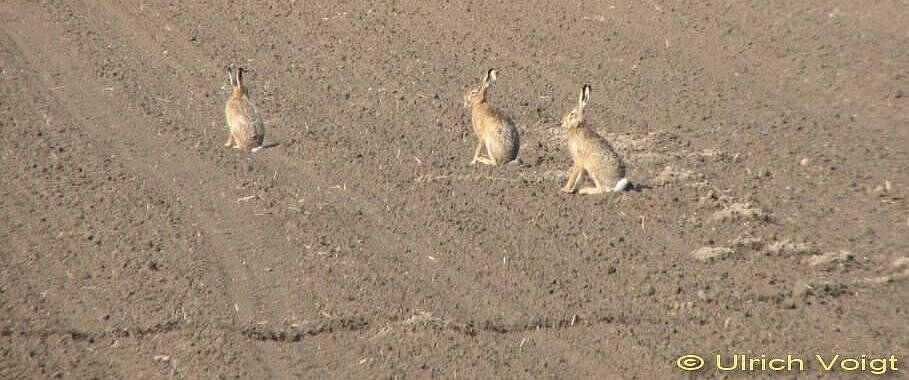
| Project data | |
|---|---|
| Projekt leader: | Prof. Prof. h. c. Dr. Ursula Siebert |
| Scientific work: | Jana Christina Klink |
| Project term: | January 2020 until December 2020 |
| Cooperationspartner: |
KielWildlife Cadastre of the Institute for Natural Resource Conservation (INR), University of Kiel National Hunting Association Schleswig-Holstein (LJV SH) |
| Sponsorship: | Ministerium für Energiewende, Landwirtschaft, Umwelt, Natur und Digitalisierung des Landes Schleswig- Holstein (MELUND) |
Project description
For several years, hunters in Schleswig-Holstein have observed an increase in diseased and deceased hares, depending on the region, as well as a decrease in hunting distances. The results of the spotlight taxations also show that despite relatively constant spring populations, the hares counted during the autumn taxations have been decreasing for several years. For this reason, 190 hunting hares from selected hunting grounds, as well as 79 fall hares from all over Schleswig-Holstein, have already been examined in detail for infectious diseases as a potential cause for the decline in the hare population in 2016 - 2019. Histological, virological, parasitological and microbiological samples were taken from each animal in addition to collecting physiological data. The occurrence of tularemia (Francisella tularensis), as well as Rabbit Haemorrhagic Disease Virus Type 2 (RHDV-2) and European Brown Hare Syndrome Virus (EBHSV) was checked in cooperation with specialized institutes. In this way, we have already been able to gain an impression of the incidence of infection over a number of years and have identified territory-specific differences, which we are now attempting to clarify further.
The results of the investigations so far show above all changes in the digestive organs, an increased exposure to parasites and indicate a high infestation with EBHSV. In the past year of investigation, RHDV2 was detected for the first time in rabbits from Schleswig-Holstein. Although high mortality rates after infection with this virus have been shown in rabbits in other countries, RHDV2 has not been detected in any rabbits in this study. Whether rabbits play a role as a source of infection for hares in Schleswig-Holstein will also be investigated in more detail.
As in previous years, the results will be evaluated together with the Landesjagdverband S.-H. and the Wildtierkataster S.-H., whereby further investigation strategies or precautionary measures will be developed. This project supports the further development of preventive health protection and food safety measures for wild animals in Schleswig-Holstein.
Project results
For several years the hunters of Schleswig- Holstein observed an increase of sick an dead european brown hares (Lepus europaeus). Therefore the Institute for Terrestrial and Aquatic Wildlife Research (ITAW) of the University of Veterinary Medicine Hannover in cooperation with the Wildtierkataster Schleswig- Holstein (WTK) of the University of Kiel, as well as the Landesjagdverband Schleswig- Holstein (LJV- SH) started in 2016 to examine european brown hares for infectious diseases. The study was funded for four years by the Ministerium für Energiewende, Landwirtschaft, Umwelt, Natur und Digitalisierung des Landes Schleswig- Holstein (MELUND).
With the support of the hunters of Schleswig- Holstein it was possible to examine in total 356 european brown hares during the study in the years 2016, 2017, 2019 and 2020. We dissected the hares and histological, virological, parasitological and microbiological samples were taken from each animal. The occurrence of tularemia (Francisella tularensis), as well as Rabbit Haemorrhagic Disease Virus Type 2 (RHDV-2) and European Brown Hare Syndrome Virus (EBHSV) was examined in cooperation with specialized institutes.
In comparison, in the year 2020 less pathological findings were diagnosed than in 2016 and 2017, but more than in 2019. The gastrointestinal tract of the hares was affected the most and and an increased exposure with parasites was confirmed. We also found a lot of hares with subclinical hepatitis and follicular hyperplasia of the spleen, which could be due to an infection with the european brown hare virus (EBHSV), as antibody titers confirmed that almost all hares that we examined were in contact with the virus. EBHSV is highly contagious and causes a high mortality which could lead to a massive decline of the population.
Like in the former years we diagnosed steatitis and nephritis in multiple hares, the origin of these pathological findings is not confirmed yet.
In 2020 stomach content and livers of 10 hares were examined at the Institute or Animal Nutrition of the University of Veterinary Medicine Hannover for the quanitity of vitamine E and unsaturated fatty acids. The number of examined animals was really low, but the results indicate that the steatitis could be caused by a vitamine E deficiency while having an excess of unsaturated fatty acids. Futher studies need to be done to confirm this.
To find the reason for the decline of the european brown hare population multidisciplinary research is needed as there are multiple factors that cause the decrease. By studying the health status of the european brown hares for multiple years we have been able to gain an impression of the occurance of infectious diseases in the population of Schleswig- Holstein.


